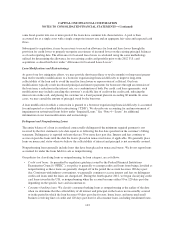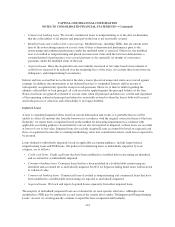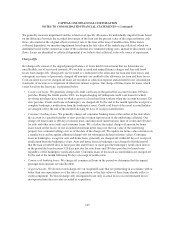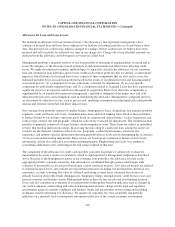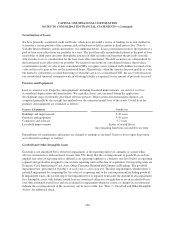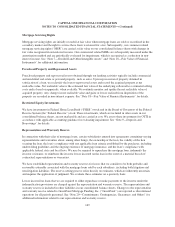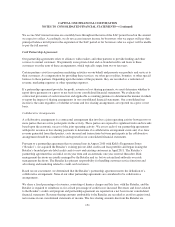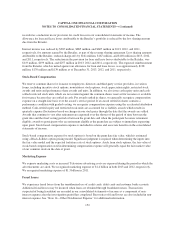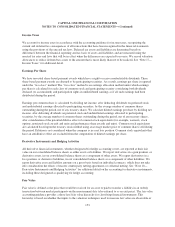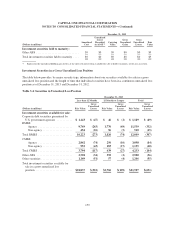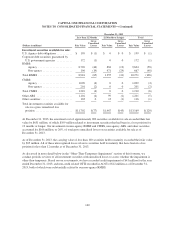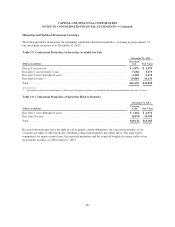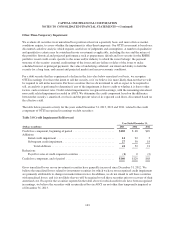Capital One 2013 Annual Report Download - page 173
Download and view the complete annual report
Please find page 173 of the 2013 Capital One annual report below. You can navigate through the pages in the report by either clicking on the pages listed below, or by using the keyword search tool below to find specific information within the annual report.CAPITAL ONE FINANCIAL CORPORATION
NOTES TO CONSOLIDATED FINANCIAL STATEMENTS—(Continued)
Income Taxes
We account for income taxes in accordance with the accounting guidance for income taxes, recognizing the
current and deferred tax consequences of all transactions that have been recognized in the financial statements
using the provisions of the enacted tax laws. Deferred tax assets and liabilities are determined based on
differences between the financial reporting and tax basis of assets and liabilities and are measured using the
enacted tax rates and laws that will be in effect when the differences are expected to reverse. We record valuation
allowances to reduce deferred tax assets to the amount that is more likely than not to be realized. See “Note 17—
Income Taxes” for additional detail.
Earnings Per Share
We have unvested share-based payment awards which have a right to receive nonforfeitable dividends. These
share-based payment awards are deemed to be participating securities. As a result, earnings per share is reported
under the “two-class” method. The “two-class” method is an earnings allocation method under which earnings
per share is calculated for each class of common stock and participating security considering both dividends
declared (or accumulated) and participation rights in undistributed earnings as if all such earnings had been
distributed during the period.
Earnings per common share is calculated by dividing net income, after deducting dividends on preferred stock
and undistributed earnings allocated to participating securities, by the average number of common shares
outstanding during the period, net of any treasury shares. We calculate diluted earnings per share by dividing net
income, after deducting dividends on preferred stock and undistributed earnings allocated to participating
securities, by the average number of common shares outstanding during the period, net of any treasury shares,
after consideration of the potential dilutive effect of common stock equivalents (for example, warrants, stock
options, restricted stock awards and units and performance share awards and units). Common stock equivalents
are calculated based upon the treasury stock method using an average market price of common shares sold during
the period. Dilution is not considered when the company is in a net loss position. Common stock equivalents that
have an antidilutive effect are excluded from the computation of diluted earnings per share.
Derivative Instruments and Hedging Activities
All derivative financial instruments, whether designated for hedge accounting or not, are reported at their fair
value on our consolidated balance sheets as either assets or liabilities. We report derivatives in a gain position, or
derivative assets, in our consolidated balance sheets as a component of other assets. We report derivatives in a
loss position, or derivative liabilities, in our consolidated balance sheets as a component of other liabilities. We
report derivative asset and liability amounts on a gross basis based on individual contracts, which does not take
into consideration the effects of master counterparty netting agreements or collateral netting. See “Note 10—
Derivative Instruments and Hedging Activities” for additional detail on the accounting for derivative instruments,
including those designated as qualifying for hedge accounting.
Fair Value
Fair value is defined as the price that would be received for an asset or paid to transfer a liability in an orderly
transaction between market participants on the measurement date (also referred to as an exit price). The fair value
accounting guidance provides a three-level fair value hierarchy for classifying financial instruments. This
hierarchy is based on whether the inputs to the valuation techniques used to measure fair value are observable or
153


